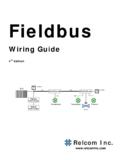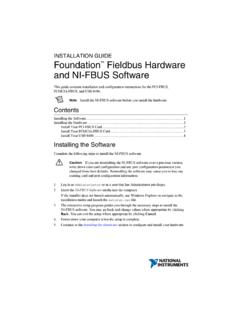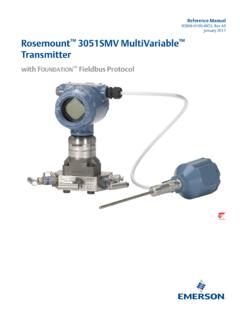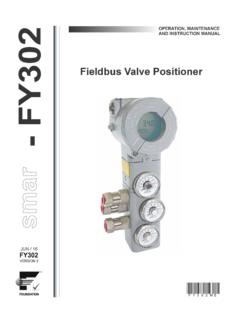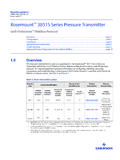Transcription of Comparison of FieldBus Systems, CAN, TTCAN, …
1 Comparison of FieldBus Systems, CAN, ttcan , flexray and LIN in Passenger Vehicles Steve C. Talbot and Shangping Ren Illinois Institute of Technology Chicago, Illinois 60616, USA {talbste, Abstract The Controller Area Network (CAN) architecture was developed for use in automobiles in the 1980 s. It corresponds to the physical and datalink layers of the OSI network protocol stack. Manufacturers currently leverage and build upon this architecture to enable on-vehicle sensors, actuators and other commercial electronics to interoperate: communicate between different components, exchange data, and resolve operational dependencies. This paper examines the inner details of CAN and its three competitive networks, namely, ttcan , flexray and LIN. Keywords: automotive networks, autonomous, availability, bit stuffing, certification, CPS, distributed, error management, event-triggered, frames, fault tolerance, global reference time, master-slave, message arbitration, message retransmisison, mono polarity bit sequence, QoS, reconfiguring, real-time, resource management, scheduling, security, time-triggered, ubiquitous, validation, verification I.}
2 INTRODUCTION Since its inception, CAN has been extended to a myriad of embedded electronic application domains, including domestic appliances, military equipment and medical devices [6] to name a few. As an increasing number of embedded electronic components are added to vehicles in order to meet rising consumer demand for product features, the complexity of each embedded component as well as the complexity of groups or sub-systems of components (which intercommunicate) is rising exponentially along with the onset of time. CAN is an example of a complex Cyber Physical system (CPS), or a deeply embedded electronic system with locally autonomous or semi-autonomous sensors and actuators, having components which are coordinated across a network. CPS networks often have no server or central processing module, leaving local components to handle real-time-constrained sensor and actuator events and following strict Quality of Service (QoS) requirements [5].
3 Using the CPS approach in automotive networks reduces cost and helps meet QoS requirements. CAN was the first automotive network approach to be developed, with LIN developed later for lightweight components and flexray developed later for high performance components. Very high-speed flexray networks (10 MBit/s) or high-speed CAN networks (1 MBit/s) are typically used to implement engine control, transmission control, braking, steering, suspension control, assistance systems, safety systems and diagnostics. Both low-speed (125 kBit/s) CAN networks or LIN networks (up to 10 kBit/s) are typically used to implement control of displays, lighting, alarm systems, air conditioner control, seat and mirror adjustment, power windows, windshield wipers and headlamps [9]. The remainder of this paper is organized into the following sections: Section 2 discusses the relevance of this paper in regards to the current existing literature.
4 Section 3 is a brief discussion about automotive FieldBus systems. Section 4 discusses further about some of the basics for each system . Section 5 discusses message arbitration found in CAN, ttcan and flexray . Section 6 discusses the format of message frames . Section 7 discusses error management. Finally, we conclude in Section 8. II. BACKGROUND AND RELATED WORK CAN was developed in the 1980 s to account for the perceived deficiencies of the I2C and D2B networks as used in automobiles at the time. This development resulted in the production of a set of international standardized documents describing CAN in the form of ISO 11898-1 through ISO 11898-5 (physical, high-speed, low-speed fault-tolerant / LS FT CAN, time-triggered / ttcan , miscellaneous, respectively) and in the form of ISO-16845 (CAN Conformance Testing) [1, 8]. In addition, a group of manufacturers independent of ISO formed CiA (CAN in Automation) for the purpose of marketing CAN and to develop documentation that exceeds and clarifies the standard CAN ISO documents [1, 8].
5 These documents include CiA Draft Standards (DS) (discussing the physical layer) and CAN Application Layers (discussing the software application layer). The company Freescale (Motorola) developed the LIN network, and the document LIN specification v. is its current authoritative document. A consortium of automobile manufacturers developed the flexray network, resulting in the flexray Protocol Specification v. [1]. These documents are solely concerned with describing their respective domains, with little Comparison made to rival networks. Reference [8] describes the CAN network using the ISO-11898-x documents as a basis, with the purpose of clarifying these fairly terse CAN specifications for a technical audience that has no prior experience with CAN. Reference [1] is also concerned with educating the technical community about automotive networks, but takes a broader approach by including details about CAN, ttcan , flexray , LIN and other networks in a single volume.
6 However, although the intention of reference [1] is to describe these networks and to compare these networks by including them side-by-side, few direct contrasts are developed between the networks. In addition, none of these documents are much concerned with comparing the QoS attributes between these networks, nor with describing how these networks relate to CPS. This survey paper attempts to describe an overview of the low-level details of the CAN, ttcan , flexray and LIN automotive FieldBus networks. Direct comparisons are made at the end of each section between these networks, with attention paid specifically to the QoS attributes pertinent to each network. In addition, a table is included following Section 8 to describe how the details of each of these networks relate to the CPS paradigm. III. AUTOMOTIVE FieldBus SYSTEMS Electronic vehicle system networks such as CAN, ttcan , flexray or LIN have many advantages.
7 First, the cost of implementing the cabling for these networks is lower than traditional approaches. These are serial bus systems (all communicating components connected to the bus) which reduce the amount of cabling required over traditional point-to-point networks (all communicating components directly connected to all other communicating components) for the wiring harness of the vehicle and simplify vehicle assembly. In addition, the lower number of plug connections of a serial bus system corresponds to fewer wires and increases dependability and reliability. Second, control is typically distributed to the individual Electronic Control Units (ECUs) locally positioned at the specific control system . Service technicians can plug into the network and access any unit on the network using a common software package, and be capable of communicating with any component in the network (manufactured by any Original Equipment Manufacturer, OEM or vendor).
8 Third, hard real-time requirements, parameters which must not deviate from strict limits (real-time braking control, real-time engine control) in order to avoid catastrophic events can be realized by meeting so-called real-time operation levels. This means that very fast response times to real-time physical events (less than 100 microseconds, which is unnoticeable to a human observer) are realized. This list of advantages supports the use of deeply embedded control systems in vehicles and is the rationale motivating the switch from mechanical systems to brake-by-wire and drive-by-wire electronic systems [7, 8]. Conventional FieldBus addressing schemes use both source and destination addresses. CAN avoids using addresses; instead, it requires that each node transmit its messages to all other nodes in the network via the bus linking all nodes in the network together. The receiving nodes filter incoming messages, only accepting messages which have message types that they have been registered to recognize before-hand.
9 This approach increases network elasticity by allowing new nodes to be added to the network without requiring prior registration with the other nodes, so long as these new nodes have been programmed to recognize the existing set of message types [1]. Four commonly used electronic systems in passenger vehicles are CAN, ttcan , flexray and LIN. In the following sections, we will discuss and compare each in detail. IV. BASICS CAN is a serial FieldBus communication network. CAN uses a bus to transmit messages between nodes in the network. The bus arrangement reduces the number of connections between nodes. Each node has a single 2-way connection to the bus. Point-to-point connections, by contrast, require an individual link between every node. The bus arrangement requires n connections for n nodes while a point-to-point arrangement requires (n(n-1))/2 connections for n nodes.
10 The bus arrangement provides a significant reduction in cost and reduces propagation delays. The fact that it is a serial bus indicates that only a single message can reside on the network at a time. CAN is a distributed real-time network used in the field ( FieldBus ) where real-time events occur [1]. Basic CAN is event-oriented (event-triggered), meaning that messages are generated in response to the generation of events on the network. Nodes send messages following an action (receives a data frame) or a request for information (receives a remote frame). However, due to the nature of CAN message arbitration where the outcome of and the time required to resolve each arbitration is completely dependent on the value of the message ids at the time of arbitration, the times required to send and receive messages cannot be characterized deterministically. This is considered to be insufficient for real-time [3] applications where hard real-time constraints impose strict requirements on the ability of network nodes to intercommunicate.
